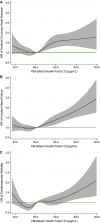Fibroblast growth factor-23 and incident coronary heart disease, heart failure, and cardiovascular mortality: the Atherosclerosis Risk in Communities study
- PMID: 24922628
- PMCID: PMC4309096
- DOI: 10.1161/JAHA.114.000936
Fibroblast growth factor-23 and incident coronary heart disease, heart failure, and cardiovascular mortality: the Atherosclerosis Risk in Communities study
Abstract
Background: Fibroblast growth factor-23 (FGF-23) is a hormone involved in phosphorous regulation and vitamin D metabolism that may be associated with cardiovascular risk, and it is a potential target for intervention. We tested whether elevated FGF-23 is associated with incident coronary heart disease, heart failure, and cardiovascular mortality, even at normal kidney function.
Methods and results: A total of 11 638 Atherosclerosis Risk In Communities study participants, median age 57 at baseline (1990-1992), were followed through 2010. Cox regression was used to evaluate the independent association of baseline serum active FGF-23 with incident outcomes. Models were adjusted for traditional cardiovascular risk factors and estimated glomerular filtration rate. During a median follow-up of 18.6 years, 1125 participants developed coronary heart disease, 1515 developed heart failure, and 802 died of cardiovascular causes. For all 3 outcomes, there was a threshold, whereby FGF-23 was not associated with risk at <40 pg/mL but was positively associated with risk at >40 pg/mL. Compared with those with FGF-23 <40 pg/mL, those in the highest FGF-23 category (≥ 58.8 pg/mL) had a higher risk of incident coronary heart disease (adjusted hazard ratio, 95% CIs: 1.65, 1.40 to 1.94), heart failure (1.75, 1.52 to 2.01), and cardiovascular mortality (1.65, 1.36 to 2.01). Associations were modestly attenuated but remained statistically significant after further adjustment for estimated glomerular filtration rate. In stratified analyses, similar results were observed in African Americans and among persons with normal kidney function.
Conclusions: High levels of serum FGF-23 were associated with increased risk of coronary heart disease, heart failure, and cardiovascular mortality in this large, biracial, population-based cohort. This association was independent of traditional cardiovascular risk factors and kidney function.
Keywords: Atherosclerosis Risk In Communities; cardiovascular mortality; coronary heart disease; epidemiology; fibroblast growth factor 23; heart failure.
© 2014 The Authors. Published on behalf of the American Heart Association, Inc., by Wiley Blackwell.
Figures

References
-
- Shimada T, Hasegawa H, Yamazaki Y, Muto T, Hino R, Takeuchi Y, Fujita T, Nakahara K, Fukumoto S, Yamashita T. FGF‐23 is a potent regulator of vitamin D metabolism and phosphate homeostasis. J Bone Miner Res. 2004; 19:429-435. - PubMed
-
- Heine GH, Seiler S, Fliser D. FGF‐23: the rise of a novel cardiovascular risk marker in CKD. Nephrol Dial Transplant. 2012; 27:3072-3081. - PubMed
-
- Shigematsu T, Kazama JJ, Yamashita T, Fukumoto S, Hosoya T, Gejyo F, Fukagawa M. Possible involvement of circulating fibroblast growth factor 23 in the development of secondary hyperparathyroidism associated with renal insufficiency. Am J Kidney Dis. 2004; 44:250-256. - PubMed
-
- Gutierrez O, Isakova T, Rhee E, Shah A, Holmes J, Collerone G, Juppner H, Wolf M. Fibroblast growth factor‐23 mitigates hyperphosphatemia but accentuates calcitriol deficiency in chronic kidney disease. J Am Soc Nephrol. 2005; 16:2205-2215. - PubMed
Publication types
MeSH terms
Substances
Grants and funding
- HHSN268201100012C/HL/NHLBI NIH HHS/United States
- HHSN268201100009I/HL/NHLBI NIH HHS/United States
- R01 HL103706/HL/NHLBI NIH HHS/United States
- HHSN268201100010C/HL/NHLBI NIH HHS/United States
- HHSN268201100008C/HL/NHLBI NIH HHS/United States
- R01 DK089174/DK/NIDDK NIH HHS/United States
- HHSN268201100007C/HL/NHLBI NIH HHS/United States
- HHSN268201100011I/HL/NHLBI NIH HHS/United States
- HHSN268201100011C/HL/NHLBI NIH HHS/United States
- HHSN268201100006C/HL/NHLBI NIH HHS/United States
- HHSN268201100005I/HL/NHLBI NIH HHS/United States
- HHSN268201100007I/HL/NHLBI NIH HHS/United States
- UL1 TR001079/TR/NCATS NIH HHS/United States
- HHSN268201100005G/HL/NHLBI NIH HHS/United States
- HHSN268201100008I/HL/NHLBI NIH HHS/United States
- HHSN268201100009C/HL/NHLBI NIH HHS/United States
- HHSN268201100005C/HL/NHLBI NIH HHS/United States
LinkOut - more resources
Full Text Sources
Other Literature Sources
Medical

